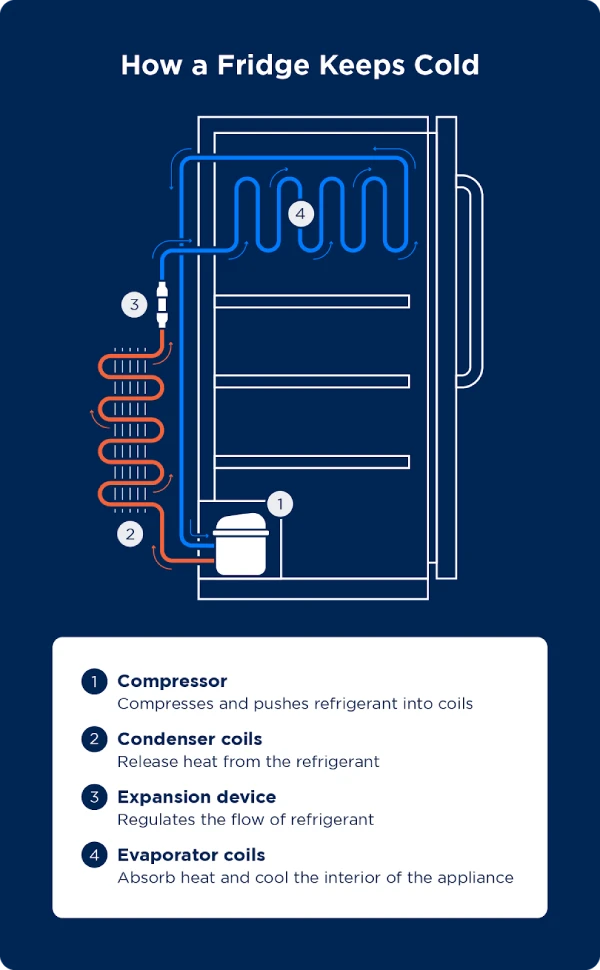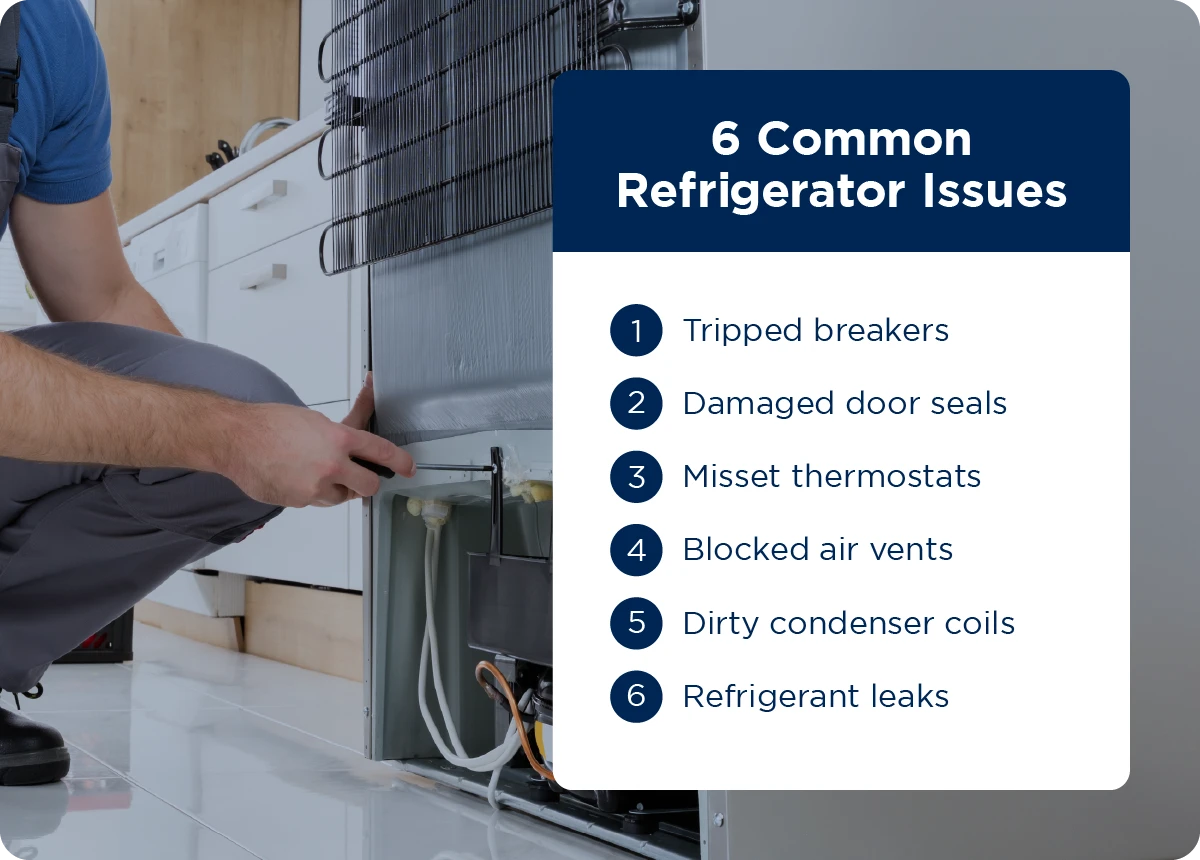A refrigerator that’s not cooling can be a major inconvenience. It’s a common household issue many face.
Imagine opening your fridge, expecting a cold drink, only to find everything at room temperature. Not only does this spoil your refreshments, but it can also lead to wasted food and money. Understanding the root of the problem is key to a quick fix.
A refrigerator’s job is simple: to keep food cold and fresh. So when it fails to cool, it’s a clear sign something’s wrong. There could be various reasons, from a faulty compressor to a clogged coil. This article will explore the potential causes of a non-cooling fridge. We’ll discuss simple checks you can perform, when to call in a professional, and how to prevent future issues. Stay with us to get your fridge back to its best.
Common Causes Of Refrigerator Cooling Issues
Is your fridge not cooling as it should? This can be frustrating and spoil your food. Let’s explore common reasons why this happens.
Faulty Thermostat Settings
The thermostat controls the fridge’s temperature. Wrong settings can lead to cooling problems. Here’s what to check:
- Make sure the thermostat is not set too high.
- It should be in the middle range for optimal cooling.
Reset the thermostat if the settings seem off. This can fix the issue.
Clogged Coils And Vents
Dust and debris can block coils and vents. This affects airflow and cooling. Here’s a quick guide:
- Unplug your fridge first for safety.
- Locate the coils, usually behind or beneath the fridge.
- Use a coil brush to clean them.
- Check vents inside the fridge. Remove any blockages.
Clean coils and vents every six months to prevent issues.
Initial Steps To Diagnose A Non-cooling Fridge
Finding out why a fridge isn’t cooling can be tricky. But, don’t worry. Start with some easy steps. These help understand the problem. Let’s dive into the initial steps to diagnose a non-cooling fridge.
Check The Power Source
First, ensure the fridge is plugged in. Sounds simple, right? Sometimes, plugs get loose. Or power goes out. Check if the light inside the fridge turns on. No light? Check your home’s circuit breaker. It might have tripped. If so, reset it.
- Make sure the plug is fully in.
- Look at the fridge light. It should be on.
- Check the circuit breaker. Reset if needed.
Inspect Door Seals For Leaks
Next, look at the door seals. They keep cold air inside. If they’re damaged, cold air escapes. This makes the fridge work harder. It might not cool well.
Here’s how to check:
- Open the fridge door.
- Look at the seals. They should be clean and intact.
- Feel for air leaks. Use your hand.
If seals are dirty, clean them. Use soapy water. Rinse well. Dry completely. If they’re damaged, consider replacing them.
Thermostat Troubles And Solutions
Is your refrigerator not cooling properly? The thermostat might be the culprit. This small device controls the fridge’s temperature. If it fails, your appliance won’t maintain the right coolness. Let’s dive into common thermostat problems and how to fix them.
Adjusting The Temperature Control
First, check the temperature setting. Sometimes, it’s simply set too high. Follow these steps to adjust it:
- Find the thermostat dial or touchpad.
- Set it to the middle range.
- Wait 24 hours. This lets the fridge stabilize.
Signs of correct temperature:
- Fridge feels cool to the touch.
- Food stays fresh longer.
When To Replace The Thermostat
If adjusting doesn’t work, it’s time for a new thermostat. Look for these signs:
| Sign | Meaning |
|---|---|
| Fridge too warm | Thermostat not signaling cooling cycle |
| Fridge too cold | Thermostat stuck on |
| Runs non-stop | Thermostat may be faulty |
Replacing a thermostat is a delicate task. Consider a professional for this job. This ensures your fridge works well and saves energy.

Condenser Coils: Cleaning And Maintenance
Condenser Coils: Cleaning and Maintenance play a crucial role in a refrigerator’s cooling system. Dirty or clogged coils can hinder the cooling process, leading to a warm fridge. Regular cleaning ensures your refrigerator runs efficiently.
Locating The Condenser Coils
Identifying the location of the condenser coils is the first step. Most coils are found behind the fridge or across the bottom. Check your fridge’s manual for the exact location.
How To Clean The Coils
Cleaning the coils boosts your fridge’s performance. Follow these simple steps:
- Unplug the refrigerator to ensure safety.
- Remove the base grille or rear panel to access the coils.
- Use a refrigerator coil brush or a soft-bristle brush to gently remove dust and debris.
- Vacuum the loosened particles to prevent them from spreading.
- Replace the grille or panel and plug the fridge back in.
Perform this maintenance biannually for best results.
Airflow Problems And Fixes
One common issue with refrigerators not cooling is airflow problems. Proper airflow is crucial. It keeps the fridge and its contents cool. Without it, your refrigerator struggles and fails to maintain the right temperature. Let’s dive into how to spot and fix these issues.
Identifying Airflow Blockages
First, we need to find what’s blocking the air. Several things can cause blockages:
- Overpacked shelves: Too many items can stop air from moving.
- Blocked vents: Items in front of vents prevent air flow.
- Dust and debris: These can clog vents over time.
Check these areas in your fridge. Make sure nothing blocks the air.
Reorganizing Fridge Contents
Next, let’s fix the airflow. Here’s how:
- Remove clutter: Take out unnecessary items.
- Rearrange items: Ensure nothing blocks the vents.
- Clean vents: Use a soft brush to remove dust.
These steps help air move freely. Your fridge should cool better now.

The Role Of The Evaporator Fan
Imagine the evaporator fan as the unsung hero in your refrigerator’s cooling process. This fan plays a crucial role by circulating cold air throughout the fridge and freezer compartments. When working correctly, it ensures a consistent temperature, keeping food fresh and safe. But what happens when this fan encounters problems?
Symptoms Of A Malfunctioning Fan
Signs of a faulty evaporator fan include:
- Warm air inside the fridge despite a running compressor.
- Unusual noises coming from the freezer compartment.
- Frost building up in the freezer, indicating disrupted air flow.
- The refrigerator cycles on and off more frequently.
Replacing The Evaporator Fan
If the fan fails, it’s often best to replace it. Follow these steps:
- Unplug the fridge for safety.
- Remove the freezer’s shelves and back panel.
- Take out the old fan and install the new one.
- Replace the panel and shelves before plugging the fridge back in.
Consult the refrigerator’s manual or a professional for guidance. Regular maintenance can prevent fan issues and extend fridge life.
Compressor Issues And Repair
One common issue with refrigerators not cooling is compressor problems. Let’s dive into what this means and how to fix it.
Signs Of Compressor Failure
Several signs indicate a failing compressor. These include:
- Loud noise from the fridge’s back
- The fridge does not stay cold
- The compressor is hot to the touch
Noticing these signs early can save your fridge.
The Cost Of Compressor Replacement
Replacing a compressor can be costly. The price varies but involves:
- Labor costs
- The price of the new compressor
| Part | Cost |
|---|---|
| Compressor | $100-$600 |
| Labor | $150-$500 |
Compressor issues require immediate attention. Check signs and consult a professional for repair options.
:max_bytes(150000):strip_icc()/refrigerator-is-not-cooling-5104936-hero-7d21f01ff9dd4874898cfdb3bf737595.jpg)
Professional Vs. Diy Repairs
Discovering your refrigerator isn’t cooling can be a moment of panic. Is it time to call in the pros, or can you tackle the problem yourself? Knowing when to seek professional help and what you can do on your own is crucial. Let’s explore the options.
When To Call A Technician
Complex issues require professional skills. Sometimes, refrigerators face problems beyond the layperson’s expertise.
- Strange noises: Could signal a serious malfunction.
- Electrical problems: Risky without proper training.
- Refrigerant leaks: Special handling and disposal needed.
Technicians have the tools and know-how to diagnose and fix these issues safely and effectively.
Simple Repairs You Can Do Yourself
Some fixes don’t need expert hands. Here are a few things you can check and correct on your own.
- Power Supply: Ensure the fridge is plugged in.
- Thermostat Settings: Reset if necessary.
- Vent Blockage: Clear any obstructed air vents.
These are just a few simple solutions that might restore your refrigerator’s cooling power.
Preventive Measures For Future Cooling Efficiency
Preventive Measures for Future Cooling Efficiency are crucial for a refrigerator’s longevity. These steps ensure the appliance performs at its best. A fridge not cooling can disrupt daily life. Let’s explore measures to avoid such problems.
Regular Maintenance Tips
- Check the condenser coils twice a year.
- Clean the interior with a mild detergent.
- Inspect door seals for tightness and cleanliness.
- Defrost manually, if not self-defrosting.
- Replace water filters regularly.
These steps keep your fridge running smoothly. They prevent unexpected breakdowns.
Investing In A Surge Protector
Power surges damage electrical components. A surge protector shields your fridge. It maintains cooling efficiency.
| Surge Protector Benefits |
|---|
| Extends appliance life |
| Prevents electrical damage |
| Ensures consistent performance |
Frequently Asked Questions
Why Is My Fridge Not Cooling Properly?
The most common reasons include a faulty thermostat, dirty coils, or an issue with the cooling system. Regular maintenance can prevent these issues. Checking and cleaning the coils, and ensuring the thermostat is set correctly may solve the problem.
Can A Dirty Fridge Cause Cooling Problems?
Yes, dirt and dust on the condenser coils can restrict airflow, causing the refrigerator to work harder and not cool efficiently. Cleaning the coils regularly can improve your fridge’s cooling performance.
How Do I Know If My Fridge Thermostat Is Broken?
If your fridge is too warm or too cold, and adjusting the thermostat doesn’t change the temperature, your thermostat might be broken. An inconsistent or incorrect temperature is a common sign of a faulty thermostat.
Is It Worth Repairing A Refrigerator That’s Not Cooling?
It depends on the age and condition of the refrigerator, as well as the cost of the repair. If the fridge is relatively new and the repair cost is less than half the price of a new fridge, it’s usually worth repairing.
Conclusion
Your refrigerator not cooling can be frustrating. It often signals a problem. Many issues could be at play here. Dirty coils or a faulty thermostat, for example. Maybe it’s a broken compressor. Regular maintenance helps prevent these issues. Always check for simple fixes first, like power supply or thermostat settings.
Need help? Contact a professional for a thorough inspection. Remember, a working fridge keeps your food fresh and safe. Don’t ignore cooling problems. Address them quickly to avoid food spoilage and extra costs. Keep your fridge running smoothly for peace of mind.







